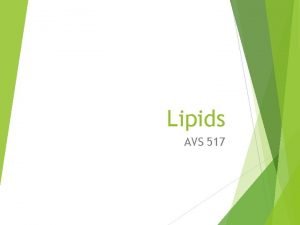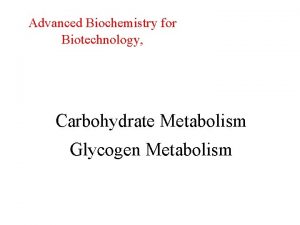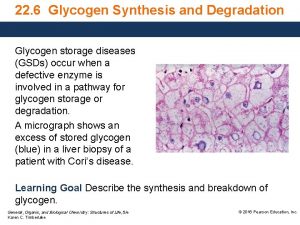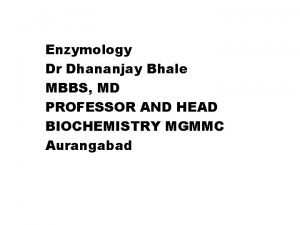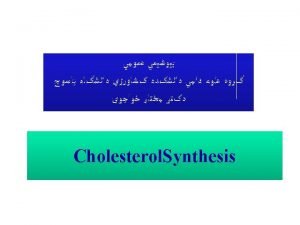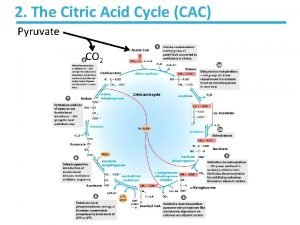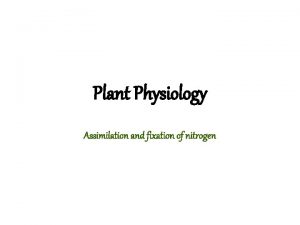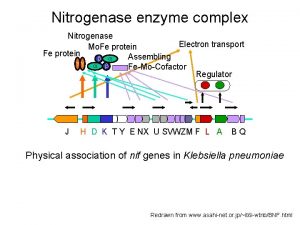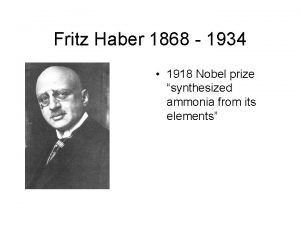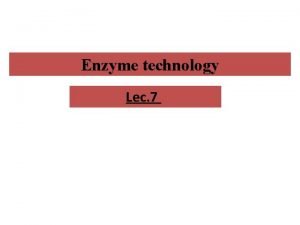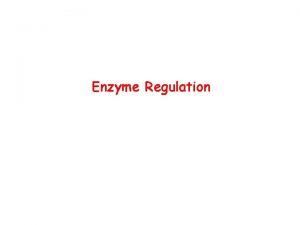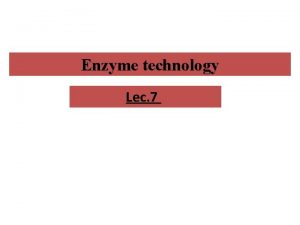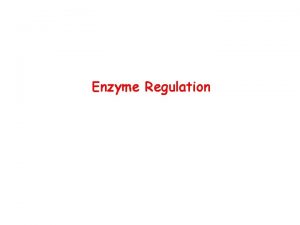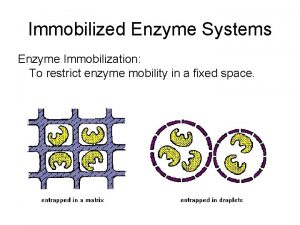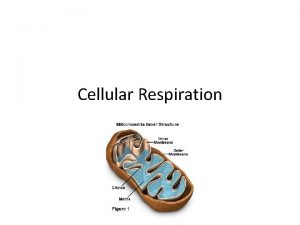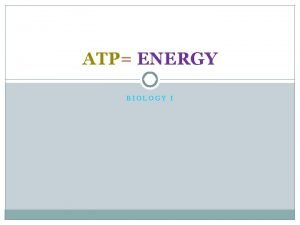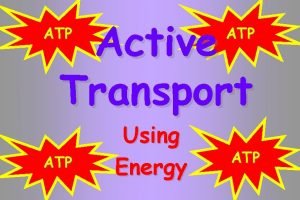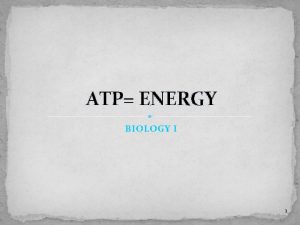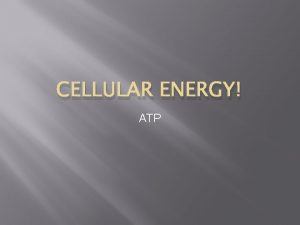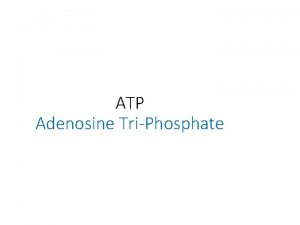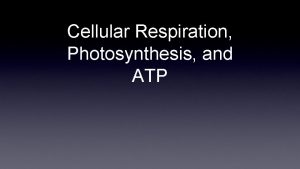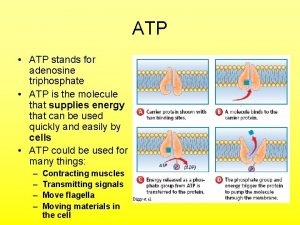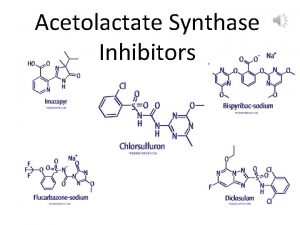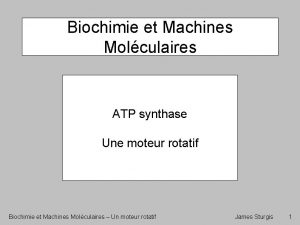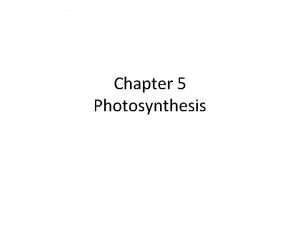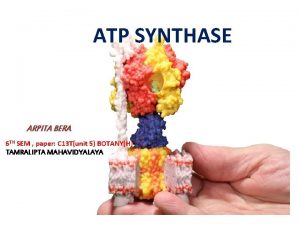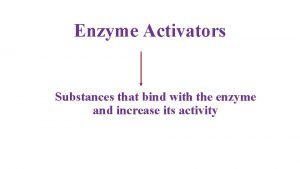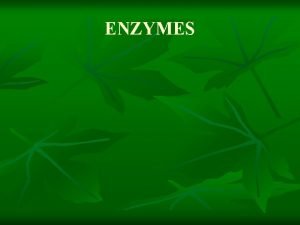ATP synthase n The enzyme complex ATP synthase






















- Slides: 22

ATP synthase n The enzyme complex ATP synthase (complex V), synthesizes ATP, using the energy of the proton gradient generated by the electron transport chain. n It is also called ATPase, because the isolated enzyme also catalyzes the hydrolysis of ATP to ADP and inorganic phosphate.

ATP synthase complexes n These complexes of proteins are referred to as inner membrane particles and are attached to the inner surface of the inner mitochondrial membrane. n They appear as spheres or ‘lollipop- like’ projections of submitochondrial particles called ‘F 1’ particles, and protrude into the mitochondrial matrix. n These are involved in ATP synthesis.

ATP synthase n ATP synthase is also called F 0 F 1 -ATPase. n This protein complex is made up of a number of subunits (F 0 subunits) and a head piece (F 1). n F 0 subunits form a pore or a channel through the membrane while headpiece F 1 sticks out into the matrix. n The F 1 part is seen as a small button on the inner mitochondrial membrane.


n Through the pore of ATP synthase, protons return to the matrix while the headpiece (of ATP synthase) catalyzes the reaction between inorganic phosphate Pi and ADP resulting in the synthesis of ATP molecule.

. n n The energy of electron transfer is efficiently conserved in proton gradient The transfer of two electrons from NADH through the respiratory chain to molecular oxygen can be written as NADH + H+ + 0. 5 O 2 ----- NAD+ + H 2 O This net reaction is highly exergonic. -220 k. J/mol (of NADH) A simi. Iar calculation for the oxidation of succinate shows a smaller, but still negative, standard free-energy change of about - 150 k. J/mol.

OXIDATIVE PHOSPHORYLATION n The transfer of electrons down the electron transport chain is energetically favored because NADH is a strong electron donor and molecular oxygen is an avid electron acceptor. n However, the flow of electrons from NADH to oxygen does not directly result in ATP synthesis.

Chemiosmotic theory (1961) n The chemiosmotic hypothesis (also known as the Mitchell hypothesis) explains how the free energy generated by the transport of electrons by the electron transport chain is used to generate ATP from ADP + Pi

n Normally, large change in free energy that occurs during electron transport could have been dissipated as heat. n However, this energy is very effectively conserved by using it in the phosphorylation of ADP to ATP. Thus, the electron transport and phosphorylation exist as tightly coupled processes.


Proton pump n Free energy change is large enough to the n This process creates across the inner mitochondrial membrane transport of protons (H+) across the inner mitochondrial membrane from the matrix to the intermembrane space. ¨ an electrical gradient (with more positive charges on the outside of the membrane than on the inside) and ¨ a p. H gradient (the outside of the membrane is at a lower than the inside). n The energy generated by this proton gradient is sufficient to drive ATP synthesis.

n Thus, the proton gradient serves as the common intermediate that couples oxidation to phosphorylation. n The ‘phosphorylation sites’ are actually the sites of proton pumping. n The proton pumping is fuelled by the exergonic redox reaction of respiratory chain. n Thus, ATP synthesis is caused by flow of the protons down their electrochemical gradient.


Hypothesis of chemiosmotic theory n The chemiosmotic hypothesis proposes that ¨ after protons have been transferred to the cytosolic side of the inner mitochondrial membrane, they reenter the mitochondrial matrix by passing through a channel in the ATP synthase complex, resulting in the synthesis of ATP from ADP + Pi and, at the same time, dissipating the p. H and electrical gradients.

Inherited defects in oxidative phosphorylation n Thirteen of the approximately 100 polypeptides required for oxidative phosphorylation are coded for by mitochondrial DNA (mt. DNA) whereas the remaining mitochondrial proteins are synthesized in the cytosol and transported into mitochondria. n Defects in oxidative phosphorylation are more likely a result of alterations in mt. DNA which has a mutation rate about ten times greater than that of nuclear DNA. n Tissues with the greatest ATP requirement (for example, CNS, skeletal and heart muscle, kidney, and liver) are most affected by defects in oxidative phosphorylation.

n Mutations in mt. DNA are responsible for several diseases n Leber's hereditary optic neuropathy, is a disease which effects CNS n There bilateral loss of central vision occurs as a result of neuroretinal degeneration, including damage to the optic nerve. n There is a single point mutation in the polypeptide of Complex I. n mt. DNA is maternally inherited because mitochondria from the sperm cell do not enter the fertilized egg.

n Alper disease is caused by deficiency of cytochrome oxidase. n Myoclonic epilepsy with ragged red fibres (MERRF) is a disease, characterized, by uncontro. Ilable muscular jerking, n It results from defective production of several of the proteins that require mitochondrial t. RNAs for their synthesis

Disorders of electron Transport chain n Mitochondrial encephalomyopathies are a heterogenous group of disorders that involve morphological abnormalities of muscle and brain mitochondria. n Leigh disease is a mitochondrial encephalomyopathy caused by oxidoreductase deficiency.

Mitochondria and Apoptosis n The process of apoptosis or programmed cell death may be initiated by the formation of pores in the outer mitochondrial membrane. n These pores allow cyt c to leave the intermembrane space and enter the cytosol. n Once in the cytosol cyt c in association with proapoptotic factors activates a family of proteolytic enzymes (the caspases), causing cleavage of key proteins and resulting in morphological and biochemical changes characteristic of apoptotic cell death.

University Questions What is chemiosmotic theory n A child accidentally took cyanide and was brought to the hospital in coma. What is the effect of this poison on mitochondril respiration n Describe complex V of ETC along with its two inhibitors n What is the role of ATP synthase in ATP production n

Draw and label a diagram to illustrate the components, organization and site specific inhibitors of ETC n Enumerate the components and functions of Complex V of respiratory chain. n

Efficiency of ETC n Efficiency of ETC is 68% as compared to ordinary engine which has 23% efficiency. n This is due to step wise oxidation of reducing equivalents instead of direct combustion of substrate to O 2
 Function of lipids
Function of lipids Pteridine synthetase
Pteridine synthetase Glycosidic bond in glycogen
Glycosidic bond in glycogen Glycogen synthase
Glycogen synthase Synthase vs synthetase
Synthase vs synthetase Hmg-coa synthase
Hmg-coa synthase Citric acid cycle overall reaction
Citric acid cycle overall reaction Nitrogenase enzyme complex
Nitrogenase enzyme complex Nitrogenase enzyme complex
Nitrogenase enzyme complex 1918 nobel prize winners
1918 nobel prize winners Freud complexes
Freud complexes Pauline and bruno have a big argument
Pauline and bruno have a big argument Mbti percentages
Mbti percentages Module 55 psychoanalytic and psychodynamic theories
Module 55 psychoanalytic and psychodynamic theories Miliary tb
Miliary tb Compound complex sentence quiz
Compound complex sentence quiz Tư thế ngồi viết
Tư thế ngồi viết Thẻ vin
Thẻ vin Bàn tay mà dây bẩn
Bàn tay mà dây bẩn Các châu lục và đại dương trên thế giới
Các châu lục và đại dương trên thế giới Bổ thể
Bổ thể Từ ngữ thể hiện lòng nhân hậu
Từ ngữ thể hiện lòng nhân hậu Tư thế ngồi viết
Tư thế ngồi viết
